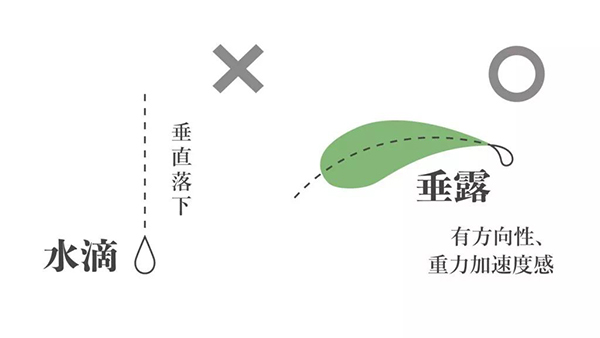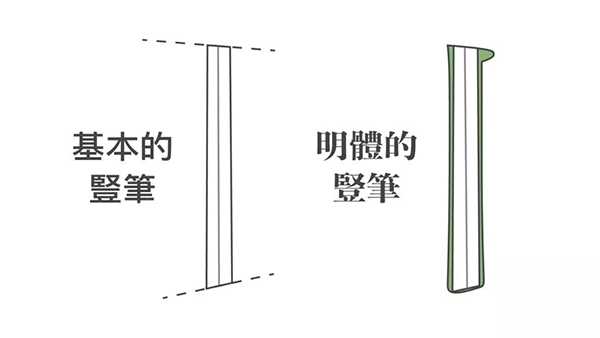Author: Liu Bokun authorized to reprint
Ming type (Song type) is a very basic and very important printing style, suitable for long-term reading, and has a high degree of recognition even in a small size. It is full of thick and thin lines and special shapes, making the text look quite elegant. Master the modeling details of the bright body, I believe that everyone can design a quite natural and spiritual bright body!
Point like a dew, skim like a knife, hook like a goose head, and press down like a sweep. There is more than one paragraph above and below the word "口", and the horizontal tail has a mountain bend and corners.
The Ming Dynasty master's witty words are like pearls, every word is pearls, and the simple four sentences have already outlined a wonderful and beautiful image of the Ming body. Each sentence brings out one or two stroke shapes, let's understand word by word below!
01
The point is like dew
-
The "point" of the bright body should be like a dew. The process of drawing is like a dynamic display, like a water drop falling from the root of the leaf vein to the tip, hanging at the end, in a state of dripping and stopping. This water droplet will not fall vertically from the sky, but rather full, with gravitational acceleration and directionality.

How to draw a "point" with a sense of drooping? First draw the skeleton, as shown by the gray line on the left side of the figure below, the two points at the start and end of the pen are the endpoints of the skeleton. Then draw a point on each side of the skeleton, and make sure that the distance between these two points and the skeleton is the same. With these four points, arcs can be used to connect the three points on both sides of the skeleton, thus completing a "point" with a sense of dew, direction and speed.
After you master the trick, you can try to change it. If the points on both sides are closer to the skeleton, they will become "points" with a sense of fine body, while the points farther away from the skeleton will be like thick body!

02
Skipping like a knife
-
Ming body's "skimming" pen is sharp, like a knife. This sentence reveals that the bright body is the essence of the carving style, and the shape of the strokes is like the appearance of a carving knife quickly carving, with very sharp curves.
How to draw the "post"? Also draw the skeleton first, and then draw the "cutting corner" of the pen, the method of finding is the same as that of the black body! After setting the cut corners, determine the thickness of the strokes, and gradually narrow them down to the other end of the skeleton with a curve, so that the basic shape of the "skimming" of the bright body is completed.
Next is the key point of Mingti drawing: "add the shape of the brush tip at the starting point", as shown in the green block. In the following, the green blocks will also be used to indicate the specially added shapes. These are the characteristics of Mingti and the key to making the strokes have charm and a reasonable sense of volume. By the way, the "lifting" stroke is drawn in the same way as the "casting" stroke, but the direction is different.

03
Hook like a goose head
-
This is an interesting and practical description. First draw the skeleton of the "hook", then thicken the strokes with black lines, and finally make a special shape of the green block at the hook.
Why do you do this? Try to cover the green block, do you find that the outline is a bit anticlimactic, and the sense of volume at the raised part cannot support the vertical stroke above? Therefore, when drawing, remember to thicken the hooked part and fill in the green block, so as to make a cute and energetic "hook" like a goose head.

04
Sweeping
-
The "捺" pen is like a broom, thin at the beginning, then thickens downwards. When drawing, also draw the skeleton first, and try to imagine the closing pen of the black body. After grasping the cut corner at the closing pen, draw thickly, and the basic shape of the pen is completed
.
Then only two more steps are needed to make Mingti's brush strokes very charming. The first step is to change the straight line at the end of the cut corner into an arc, and the second step is to turn the lower corner into a circular arc, just like a calligraphy brush, and slowly draw it outward after turning the pen.

05
One paragraph more up and down
-
After accumulating long-term experience, the engraving masters discovered that the "mouth" of the printed characters must be supported by two feet, so that the shape of the characters can be balanced and stable. The "mouth" of the black body only grows feet at the bottom, but in the case of the bright body, there will also be a special shape at the turning point at the top, which is "the word "mouth" has an extra section above and below".

Why is there such a prominent shape above the word "口"? It should be noted that the first stroke of "mouth" is a vertical stroke, and the second stroke is a turning point. Therefore, the protrusion on the upper left of the mouth is derived from the vertical stroke shape of the Ming body, and the protrusion on the upper right is related to the turning shape of the Ming body. The description of the turning shape Leave it to the last sentence of the formula, first understand the shape and painting method of the vertical stroke of the Ming body.
The basic type of the vertical pen is the upper and lower cut corners, with two parallel lines on the left and right. However, the angle between the beginning and end of the vertical stroke in the Ming style is not parallel, but incorporated into the rhyme of calligraphy. The starting stroke cuts from the upper left to the lower right, and the ending is like a mirror reflection of the starting stroke, closing from the lower left to the upper right. To make the vertical strokes more calligraphic, it is necessary to add thickness changes. First, add the shape of the brush head at the beginning of the brush, slightly widen the beginning, then narrow it inward, and gradually thicken it in the middle and rear sections, like a green area. As you can see from the block, the entire vertical stroke will show a change of "thick→thin→thick".

06
There are mountains in Yokoo
-


07
Curved corner
-

Ming style definition
Articles are uploaded by users and are for non-commercial browsing only. Posted by: Lomu, please indicate the source: https://www.daogebangong.com/en/articles/detail/Want%20to%20do%20a%20good%20job%20in%20Song%20Dynasty%20Recognize%20the%20key%20points%20of%20Song%20typeface%20first.html

 支付宝扫一扫
支付宝扫一扫 
评论列表(196条)
测试